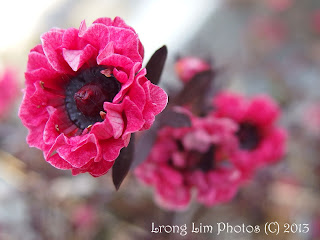Weather is becoming more pleasant these days...
In the mornings, the thermometer dips to about 1 to 2 degrees...
The mercury then shoots up to about 10 degrees on a nice, fine day...
Yes, it is time to start some seeds...
Corn, peanuts, soy beans, bitter gourd, pumpkin, okra, long beans, winged beans, loofa, and cucumber comes to mind...
I have been fooling around with the garden for about 6 or 7 years now...
Each year, I have tried my hand in crop rotation and companion planting...
Lots of failures, some successes, but always lots of fun...
Through fooling around with the plants, I have sort of, arrived at a nice combination of plants to rotate...
First, a little explanation on the physical attributes of the potager...
The size of the whole plot is about 260 square meters...
The left side is sloping, and is filled with fruit trees...
The right side is flat, and this forms the main part of the vegetable garden...
If you'd click on the image above (not to scale, of course, considering the amateur in me), you can see that our potager is divided into 4 sections...
The orientation is that, the far end is the south...
For practical purposes, we label the sections South-West (purple), South-East (red), North-East (green), and North-West (orange)...
Between the East (left side) sections and the West (right side) sections, we have a wide walk path whereby a wheelbarrow can easily pass through...
Each section has 6 vegetable beds (or its equivalent, size-wise)...
Between the vegetable beds, we have a path to walk on while working on the plants...
Each vegetable bed is about one meter by two meters...
And, all of them manually dug up by yours truly...
The two western sections are very nicely sliced up, with 6 beds each...
The NE section has 5 beds, and the size is approximately equivalent to that of the 6 beds...
The SE section has 3 beds, each about one meter by four meters...
In the center of the potager lies the permanent bed...
We plant asparagus, Chinese chives, myoga ginger, saffron, and wild strawberries....
These plants are not rotated...
The arrangement above provides the foundation to 'double' rotate the crops on a 3 or 5-year cycle, depending on the type of crops...
Specifically, asters and mustard greens run on a 3-year rotation while the rest, 5 years.
And 'double' rotation in the sense that, crops rotate along the 4 sections, and within each section, we rotate the crops amongst the vegetable beds...
Quite a bit like the earth rotating around the sun, and at the same time, the moon rotating around the earth?
I have grouped and combined the crops as follows, roughly based on their 'families'...
SW section: Beans (Peanut, soy bean, snap pea, fava bean) and Asters (Spinach, swiss chard, 'makchoy', lettuce, chrysanthemum)
SE section: Nightshades (Tomato, eggplant, potato, chilli) and Greens (Komatsu-na, shangtung-sai, mamba, broccoli, cauliflower, cabbage, chingen-sai)
NW section: Grass (Corn), Gourds (Cucumber, loofa, pumpkin, zucchini), and Greens (Kale, rocket, vitamin-na, aku-sai, ta-sai, radish)
NE section: Roots (Onion, carrot, garlic), and 'mixed', for crops that belong to different families (Amaranth, basil, kangkong, moroeya, malabar spinach, okra)
Along with these plants, we have cosmos, marigold, zinnia, borage, Korean perrilla, red and green shiso everywhere, coming in as companions and magnets for beneficial insects.
All of these plants self-seed, except the cosmos, which I hope will do likewise soon...
Each year, the plants are rotated anti-clockwise...
And within each section, I rotate the plants as I see fit (potatoes and beans are good examples)...
Up until now, I have planned the crops on the basis of two planting seasons (spring and autumn)...
After a few tries, I realize that the autumn crops have too little time to gain sufficient size to withstand the cold...
So, this year, I am going to plant as if we have only one planting season (spring, that is)...
In another part of the property, which is not in the picture, we plant long beans, winged beans, watermelon, Japanese yam, sweet potatoes, and more of tomatoes, eggplants, pumpkins, bitter gourd, and loofa....
And the fruits... perhaps on another post?











